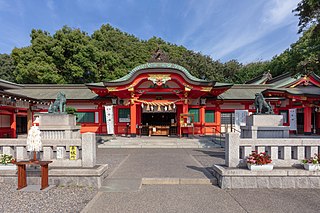 W
WGifu Gokoku Shrine is a Shinto shrine located at the base of Mount Kinka in Gifu, Gifu Prefecture, Japan. The shrine is dedicated to the 37,000 residents of Gifu Prefecture who have died in wars since the Meiji Restoration. Official ceremonies are also held at the neighboring Hotel Seiran, which is part of the shrine facilities.
 W
WHida Gokoku Shrine is a Shinto shrine located in Takayama, Gifu Prefecture, Japan. The shrine is designated to the people from the area who died during wars. The time period represented by the dead ranges from the Satsuma Rebellion in 1877 to World War II. Because it represented only a small portion of the prefecture, it was eventually replaced by the Gifu Gokoku Shrine.
 W
WHida Tōshō-gū (飛騨東照宮) is a Shinto shrine in the city of Takayama, Gifu Prefecture, Japan. It is dedicated to the first Shōgun of the Tokugawa Shogunate, Tokugawa Ieyasu.
 W
WHonjō Shrine is a Shinto shrine located in Gifu, Gifu Prefecture, Japan. Alternative kanji for the shrine are 本庄神社. Honjō Shrine was built as a larger shrine, but it was split into three separate shrines, of which the current Honjō Shrine is one. The other two are Yakumo Shrine and Rokujō Shrine, both of which are located nearby.
 W
WInaba Shrine is a Shinto shrine located at the base of Mount Kinka in Gifu, Gifu Prefecture, Japan. Originally, its name was written 稲葉神社, which is pronounced the same way. It is the main shrine that is celebrated by the city of Gifu in its annual Gifu Festival on the first Saturday of each April. Because of its size, it is a popular spot for hatsumōde and Shichi-Go-San.
 W
WKanō Tenman-gū (加納天満宮) is a Shinto shrine located in the city of Gifu, Gifu Prefecture, Japan. It was built as the shrine to protect Izumii Castle. As a Tenman-gū, it is dedicated to Tenjin, the deified form of Sugawara no Michizane. Additionally, Matsudaira Mitsushige, who first created Gifu Umbrellas, is also canonized on the shrine grounds. The shrine's festival is held on the third Saturday and Sunday of October each year.
 W
WKashimori Shrine is a Shinto shrine located in the city of Gifu, Gifu Prefecture, Japan. From long ago, it has been considered a good place for married couples and children to go for good luck. One legend associated with Kashimori Shrine is that when Tenma, a mythical horse, landed behind the shrine, it left a hoof print in stone that can still be seen today. Each year, on April 5, the shrine hosts the Gifu Festival, along with Inaba Shrine and Kogane Shrine.
 W
WKeta Wakamiya Shrine is a Shinto shrine located in the city of Hida, Gifu Prefecture, Japan. It is commonly referred to as "Sugimoto-sama" (杉本さま).
 W
WKogane Shrine is a Shinto shrine located in the city of Gifu, Gifu Prefecture, Japan. First built in 135, it has long been considered a place to pray for financial blessings. Because it is located near the city center, approximately 150,000 worshippers visit the shrine over the three-day New Year's period. On April 5, the shrine hosts the Gifu Festival with Inaba Shrine and Kashimori Shrine. The nearby Kogane Hall can be used as a communications place for the citizens of the city.
 W
WHidaichi-no-miya Minashi Shrine, commonly: Minashi Shrine is a Shinto shrine located in the city of Takayama, Gifu Prefecture, Japan.
 W
WMiwa Shrine is a Shinto shrine located in Gifu, Gifu Prefecture, Japan.
 W
WNagara Tenjin Shrine is a Shinto shrine located in the Nagara area of Gifu, Gifu Prefecture, Japan. It is a Tenman-gū dedicated to the worship of Sugawara no Michizane.
 W
WNangū Taisha (南宮大社) is a Shinto shrine located in the town of Tarui in Fuwa District, Gifu Prefecture, Japan. It is the ichinomiya of former Mino Province.
 W
WNemichi Shire is a Japanese Shinto shrine located in the city of Seki, Gifu Prefecture. Nemichi Shine has become famous for its koi pond, which has been compared to the Water Lilies paintings of Claude Monet.
 W
WNōhi Gokoku Shrine is a Shinto shrine located in Ōgaki, Gifu Prefecture, Japan. It is located near the base of Ōgaki Castle. The shrine is designated to the approximately 19,000 people from the Seino and Hida regions of Gifu Prefecture who died during wars. Because it represented only a small portion of the prefecture, it was eventually replaced by the Gifu Gokoku Shrine.
 W
WTejikarao Shrine is a Shinto shrine located in the city of Gifu, Gifu Prefecture, Japan.
 W
WYōrō Shrine is a Shinto shrine located in the town of Yōrō in Yōrō District, Gifu Prefecture, Japan.